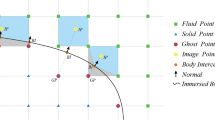Abstract
Free surface flow interaction with an elastic plate is simulated by a Constraint Interpolation Profile-based Model. A finite difference method (FDM) based on the CIP method is used for solving the flow field in a fixed staggered Cartesian grid and a finite element method (FEM) is used for dealing with the structural deformation. Beside, a volume of fluid type method, the THINC/SW (Tangent of Hyperbola for Interface Capturing with Slope Weighting) method is used to capture the free surface and a Ghost-Cell Immersed Boundary Method is adopted to couple the fluid and structure interaction. To verify the model, a rolling tank sloshing with a thin elastic plate is computed. Predicted results are found to be more agreement with the experimental results than reference data. Furthermore, two other benchmark experiments are tested, including an elastic gate deformation in dam break and a hanging elastic beam in a shallow oil sloshing. The computed results agree well with published literatures. It validates the reliability of the present solver to deal with nonlinear fluid-structure interactions.
Access this chapter
Tax calculation will be finalised at checkout
Purchases are for personal use only
Preview
Unable to display preview. Download preview PDF.
Similar content being viewed by others
References
Antoci, C., Gallati, M., & Sibilla, S. (2007). Numerical simulation of fluid-structure interaction by SPH. Computers and Structures, 85, 879-890.
Degroote, J., Antonio, S., Paepegem, W. (2010). Partitioned simulation of the interaction between an elastic structure and free surface flow. Computer Methods in Applied Mechanics and Engineering, 199, 2085-2098.
Franke, R. (1982). Scattered data interpolation: tests of some methods. Mathematics of computation, 38(157), 181-200.
Groenenboom, P., Cartwright, B. (2010).Hydrodynamics and fluid-structure interaction by coupled SPH-FE method. Journal of Hydraulic Research, 48, 61-73.
He, G., Kashiwagi, M. (2010). Nonlinear analysis on wave-plate interaction due to disturbed vertical elastic plate. Journal of Hydrodynamics, 22(5), 507-512.
Hu, C., Kashiwagi, M., & Kishev, Z. (2006). Application of CIP method for strongly nonlinear marine hydrodynamics. Ship Technology Research, 53, 74-87.
Higo, Y., Nishimura, D., & Oka, F. (2015). Dynamic analysis of unsaturated embankment considering the seepage flow by a GIMP-FDM coupled method. Computer Methods and Recent Advances in Geomechanics, pp. 1761-1766. London, UK:Taylor & Francis Group.
Idelsohn, S., Marti, J., & Onate, E. (2008). Interaction between an elastic structure and free-surface flows experimental versus numerical comparisons using the PFEM. Comput Mech, 197, 1762-1776.
Kim, W., Lee, I., & Choi, H. (2018) A weak-coupling immersed boundary method for fluid-structure interaction with low density ratio of solid to fluid. Journal of Computational Physics, 359, 296-311.
Li, M., Zhao, X., Ye, Z., Lin, W. Chen Y. (2018) . Generation of regular and focused waves by using an internal wave maker in a CIP-based model. Ocean Engineering, 167, 334-347.
Liao, K., Hu, C. (2013). A coupled FDM–FEM method for free surface flow interaction with thin elastic plate. Journal of marine science and technology, 18, 1-11.
Liao, K., Hu, C., & Duan, W. (2013). Two-dimensional numerical simulation of an elastic wedge water entry by a coupled FDM-FEM Method. Journal of Marine Science and Application, 2, 163-169.
Liao, K., Hu, C., & Sueyoshi, M. (2015). Free surface flow impacting on an elastic structure: Experiment versus numerical simulation. Applied Ocean Research, 2, 163-169.
Matthias, H., Andrew, L., & Hazel, J. (2008). Solvers for large-displacement fluid-structure interaction problems: segregated versus monolithic approaches. Comput Mech, 43, 91-101.
Miriam, M., Markus, B. (2008). An Eulerian approach for partitioned fluid-structure simulations on Cartesian grids. Comput Mech, 43, 115-124.
Paik, K., Carrica, P. (2014). Fluid-structure interaction for an elastic structure interacting with free surface in a rolling tank. Ocean. Engineering, 84, 201-212.
Rao, C., Zhang, Y., & Wan, D. (2017). Numerical simulation of the solitary wave interacting with an elastic structure using MPS-FEM coupled method. Journal of Marine Science and Application, 16, 395-404.
Tseng, Y., Ferziger, J. H. (2003). A ghost-cell immersed boundary method for flow in complex geometry. Journal of computational physics, 192(2), 593-623.
Yabe, T., Xiao F., & Utsumi, T. (2000). The constrained interpolation profile method for multiphase analysis. Journal of Computational Physics, 169, 556-593.
Ye, Z., Zhao, X., Deng, Z. (2017). Investigation of water-water interface in dam break flow with a wet bed. Journal of Hydrology, 548,104-120.
Zhao, X., Gao, Y., Cao, F., Wang, X. (2016). Numerical modeling of wave interactions with coastal structures by a constrained interpolation profile/immersed boundary method. International Journal for Numerical Methods in Fluids, 81, 265-283.
Zhao, X., Hu, C. (2012). Numerical and experimental study on a 2-D floating body under extreme wave conditions. Applied Ocean Research, 35, 1-13.
Zhao, X., Ye, Z., Fu, Y., Cao, F. (2014). A CIP-based numerical simulation of freak wave impact on a floating body. Ocean Engineering, 87, 50-63
Zhao, X., Cheng, D., Zhang, Y., Li, M. (2019). Experimental and numerical study on the hydrodynamic characteristics of solitary waves passing over a submerged breakwater. China ocean Engineering, 33(3): 253-267.
Acknowledgements
This study was partially supported by the National Natural Science Foundation of China (Grant No. 51679212), Zhejiang Provincial Natural Science Foundation of China (Grant No. LR16E090002), the Fundamental Research Funds for the Central Universities (Grant No. 2018QNA4041).
Author information
Authors and Affiliations
Corresponding author
Editor information
Editors and Affiliations
Rights and permissions
Copyright information
© 2020 Springer Nature Singapore Pte Ltd.
About this paper
Cite this paper
Zhao, X., Yang, Z., Duan, S., Liu, B. (2020). Numerical Simulation of Free Surface Flow with an Elastic Plate Using a Cip-Based Model. In: Trung Viet, N., Xiping, D., Thanh Tung, T. (eds) APAC 2019. APAC 2019. Springer, Singapore. https://doi.org/10.1007/978-981-15-0291-0_85
Download citation
DOI: https://doi.org/10.1007/978-981-15-0291-0_85
Published:
Publisher Name: Springer, Singapore
Print ISBN: 978-981-15-0290-3
Online ISBN: 978-981-15-0291-0
eBook Packages: Earth and Environmental ScienceEarth and Environmental Science (R0)




